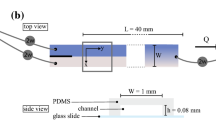Abstract
Both numerical and analytical models have been developed to explore the viscosity effect of the continuous phase on drop formation at a T-shaped junction in immiscible liquids. The effects of the generalized power law coefficient, the power law exponent and the yield stress on the mechanism of drop breakup, final drop size and frequency of drop formation are studied by using the numerical three-dimensional volume of fluid model. Droplets coalescence in Bingham fluids is observed in the beginning transient period. The effect of yield stress on drop extension is also discussed. Predictions of drop size by using an analytical force balance show satisfactory agreement with simulation results for Newtonian and power law fluids with different viscosity ratios. The approximation error associated with the analytical model for Bingham fluids is also acceptable. This analytical model can greatly shorten the prediction time as compared with the numerical model, which is helpful for on-line control.






















Similar content being viewed by others
References
Atapattu DD, Chhabra RP, Uhlherr PHT (1995) Creeping sphere motion in Herschel–Bulkley fluids: flow field and drag. J Non Newton Fluid Mech 59:245–265
Chen AU, Notz PK, Basaran OA (2002) Computational and experimental analysis of pinch-off and scaling. Phys Rev Lett 88:4501–4504
Chinyoka T, Renardy YY, Renardy M, Khismatullin DB (2005) Two-dimensional study of drop deformation under simple shear for Oldroyd-B liquids. J Non Newton Fluid Mech 130:45–56
Cramer C, Fischer P, Windhab EJ (2004) Drop formation in a co-flowing ambient fluid. Chem Eng Sci 59:3045–3058
Dreyfus R, Tabeling P, Willaime H (2003) Ordered and disordered patterns in two-phase flows in microchannels. Phys Rev Lett 90:144505
Francois MM, Cummins SJ, Dendy ED, Kothe DB, Sicilian JM, Williams MW (2006) A balanced-force algorithm for continuous and sharp interfacial surface tension models within a volume tracking framework. J Comput Phys 213:141–173
Garstecki P, Fuerstman MJ, Whitesides GM (2005) Nonlinear dynamics of a flow-focusing bubble generator: an inverted dripping faucet. Phys Rev Lett 94:234502
Giapos A, Pachatouridis C, Stamatoudis M (2005) Effect of the number of impeller blades on the drop sizes in agitated dispersions. Chem Eng Res Des 83:1425–1430
Hong YP, Li HX (2003) Comparative study of fluid dispensing modeling. IEEE Trans Electro Packag Manuf 26:273–280
Husny J, Cooper-White JJ (2006) The effect of elasticity on drop creation in T-shaped microchannels. J Non Newton Fluid Mech 137:121–136
Kim I, Kamotani Y, Ostrach S (1994) Modeling of bubble and drop formation in flowing liquids in microgravity. AIChE J 40:19–28
Leunissen ME, Blaaderen AV, Hollingsworth AD, Sullivan MT, Chaikin PM (2007) Electrostatics at the oil–water interface, stability, and order in emulsions and colloids. Proc Natl Acad Sci USA 104:2585–2590
Li D (1996) Drop size dependence of contact angles and line tensions of solid–liquid systems. Colloids Surf A 116:1–23
Li J, Renardy YY (2000) Shear-induced rupturing of a viscous drop in a Bingham liquid. J Non Newton Fluid Mech 95:235–251
Macierzanka A, Szelag H (2006) Microstructural behavior of water-in-oil emulsions stabilized by fatty acid esters of propylene glycol and zinc fatty acid salts. Colloids Surf A 281:125–137
Meier M, Yadigaroglu G, Smith BL (2002) A novel technique for including surface tension in PLIC-VOF methods. Eur J Mech B Fluids 21:61–73
Nagayasu A, Uchiyama K, Kiwada H (1999) The size of liposomes: a factor which affects their targeting efficiency to tumors and therapeutic activity of liposomal antitumor drugs. Adv Drug Deliv Rev 40:75–87
Nahra HK, Kamotani Y (2000) Bubble formation from wall orifice in liquid cross-flow under low gravity. Chem Eng Sci 55:4653–4665
Nisisako T, Torii T, Higuchi T (2002) Droplet formation in a microchannel network. Lab Chip 2:24–26
Nisisako T, Torii T, Higuchi T (2004) Novel microreactors for functional polymer beads. Chem Eng J 101:23–29
Stone HA, Stroock AD, Ajdari A (2004) Engineering flows in small devices: microfluidics towards a lab-on-a-chip. Annu Rev Fluid Mech 36:381–411
Takada N, Tomiyama A, Hosokawa S (2003) Lattice Boltzmann simulation of drops in a shear flow. In: Proceedings of the 4th ASME/JSME joint fluids engineering conference, New York, USA
Takeuchi S, Garstecki P, Weibel DB, Whitesides GM (2005) An axisymmetric flow-focusing microfluidic device. Adv Mater 17:1067–1072
Taylor GI (1932) The viscosity of a fluid containing small drops of another fluid. Proc R Soc Lond Ser A 138:41–47
Teng H, Kinoshita CM, Masutani SM (1995) Prediction of droplet size from the breakup of cylindrical liquid jets. Int J Multiphase Flows 21:129–136
Thorsen T, Roberts RW, Arnold FH, Quake SR (2001) Dynamic pattern formation in a vesicle-generating microfluidic device. Phys Rev Lett 86:4163–4166
Tice JD, Lyon AD, Ismagilov RF (2004) Effects of viscosity on droplet formation and mixing in microfluidic channels. Anal Chim Acta 507:73–77
Tucker CL (1989) Fundamentals of computer modeling for polymer processing. Hanser Publishers, New York
Van Der Graaf S, Nisisako T, Schroen CGPH, Van Der Sman RGM, Boom RM (2006) Lattice Boltzmann simulations of droplet formation in a T-shaped microchannel. Langmuir 22:4144–4152
Acknowledgments
The work is supported by NSFC (Project No: 10402044). The authors gratefully acknowledge valuable help and advice from Dr. Nisisako. Thanks must be given to the anonymous reviewers for their insights and suggestions.
Author information
Authors and Affiliations
Corresponding author
Rights and permissions
About this article
Cite this article
Sang, L., Hong, Y. & Wang, F. Investigation of viscosity effect on droplet formation in T-shaped microchannels by numerical and analytical methods. Microfluid Nanofluid 6, 621–635 (2009). https://doi.org/10.1007/s10404-008-0329-x
Received:
Accepted:
Published:
Issue Date:
DOI: https://doi.org/10.1007/s10404-008-0329-x




